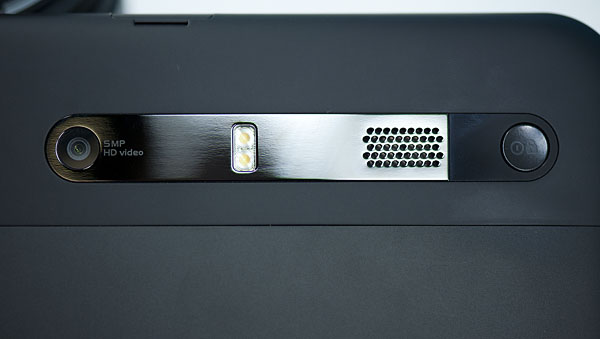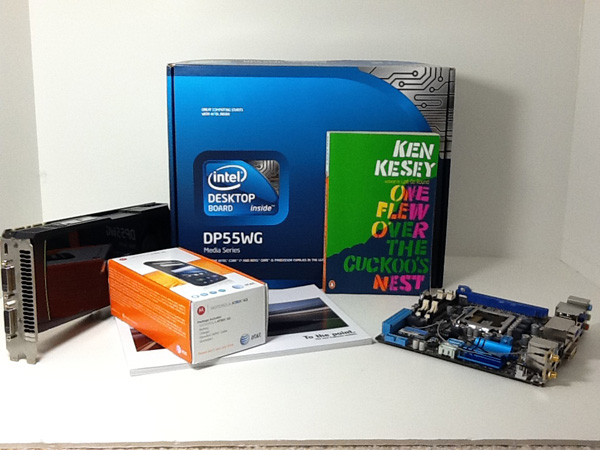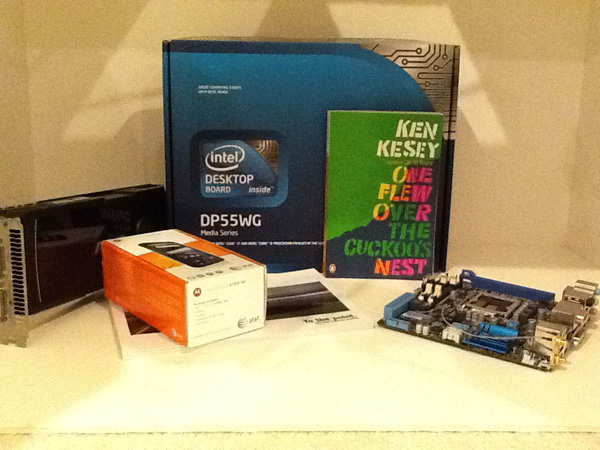The Apple iPad 2 Review
by Brian Klug, Anand Lal Shimpi & Vivek Gowri on March 19, 2011 8:01 PM ESTVideo Quality
The rear facing camera is native 1280x720 and unsurprisngly captures 720P video. It's essentially the same quality as the iPod Touch, which doesn't come as a surprise at all. There's been considerable discussion about whether this back sensor is optimized (or intended) for video. Given that 1280x720 size, it seems obvious this is likely the case. As we'll show, video on the iPad 2 is actually very good, it's still capture that suffers.
In all honesty, 720P video capture on the iPad 2 is almost as good as the iPhone 4. In addition, there's no apparent change in magnification when switching into video mode on the iPad 2 like there is on the iPhone 4. This is again because 160 pixels are tossed away on the left and right sides in still mode. Unfortunately there's no way to capture a 1280x720 still from the iPad 2 unless you shoot video and manually grab frames. Video on the rear facing camera is captured at 1280x720 at 29.970 fps H.264 Baseline (1 reference frame) at 10.6 Mbps. Audio is 1 channel AAC at 64 Kbps.
Like other iDevices, you can view the actual aspect correct capture frame by double tapping on the preview.
I took two video samples with the iPad 2, one at our usual bench location in afternoon lighting, another outside the local cafe at night to show low light performance. As usual we've uploaded both to YouTube as well as hosted originals in a big 7-zip (186 MB).
The iPad 2's 720P rear facing video capture sample in daylight is actually pretty impressive and on par with all the other iDevices. Apple still has class leading quality at 720P even when competitors are doing encodes at 1080P, and at this point it looks like their ISP and encoder is roughly the same as the A4's.
I also took one more video at another location at night. I start outdoors and then go indoors into a cafe to give a feel for low-light performance.
Front facing video isn't super impressive on its own, but again on par with other iDevices. It's 640x480 (VGA) at 29.970 fps H.264 Baseline (1 reference frame) at 3.5 Mbps. Audio is 1 channel AAC at 64 Kbps.
In spite of being just VGA the front facing video quality is quite decent. No doubt Apple is making a concious effort to go with lower resolution sensors (but with bigger pixels) instead of pushing for more megapixels on the front camera. It's a tradeoff that makes the front facing cameras on iDevices better in low light. Until FaceTime gets HD on mobile devices (and we get more mobile upstream bandwidth), VGA seems good enough.
Still Quality
It's still quality on the rear facing camera that's really disappointing. Still images are again cropped to 960x720 (4:3). The images are simply noisy and underwhelming all around. The competition is shipping higher resolution front facing cameras than what's in the iPad 2's rear facing camera, and the result is that the thing feels like it's saddled with two sub-par cameras.
We've done the usual thing and taken photos with the front and rear facing cameras in our smartphone lightbox and at the bench locations. In addition I shot photos with the iPad around town and everywhere I carried it with me.
The front facing camera seems to have some odd white balance issues, as it shows a reddish cast in our lightbox. Out in the wild, I never ran into any serious performance issues with the front facing camera, and honestly VGA seems fine for the time being until mobile devices get the bandwidth to juggle 720P videoconferencing.
I guess the issue I have with the iPad 2's cameras is that the back one already seems woefully insufficient. Apple has already demonstrated that it's possible to both have a thin device and awesome cameras with the iPhone 4. Coupled with onboard HDR, the iPhone 4 still delivers images that rival all but Nokia's best. It's just puzzling why a device that costs substantially more out the door than the iPhone 4 delivers such subpar still capture quality. In reality, thickness is probably the most important constraint here, as the iPhone 4 is thicker than the iPad 2 and thus Apple couldn't simply toss the iPhone 4 cameras inside the iPad 2. I won't speculate about Apple's motivations for going with these cameras, but the end result is a rear camera that honestly doesn't impress.
Compared to the Xoom

The Motorola Xoom's 5MP Rear Facing Camera
The Motorola Xoom's rear camera captures at 2592 x 1944 (5MP) and is assisted by an LED flash. This gives the Xoom's rear camera a 7.29x higher pixel count than what Apple offers with the iPad 2. But do more pixels mean a better looking picture? Well in this case, yes.

Mouse over to see the Motorola Xoom's camera quality

Mouse over to see the Motorola Xoom's camera quality
The iPad 2's rear camera predictably produces very saturated colors like the iPhone 4. The rear sensor is very noisy in low light situations and it's not very sharp on top of that. You'll also notice that Apple's funny white balance algorithm acts up in the shot with two external lights vs. one external light.
The Xoom by comparison is pretty consistent in terms of white balance. Motorola also produces a sharper image, although the colors are far too hazy. If Apple over compensates for color saturation, Motorola tones it down a little too much. The LED flash keeps the shot with no external lights from becoming too noisy but it also royally screws up the white balance, making the image a bit too green.
As we mentioned in our review, the Xoom is surprisingly potent when it comes to taking pictures. It's by no means great, but it's way better than the iPad 2.






























189 Comments
View All Comments
Azethoth - Monday, March 21, 2011 - link
No! 22 seconds is not fast enough. That is 20 seconds wasted each time you do that in a day.benonemusic - Monday, March 21, 2011 - link
Excellent writing and content as usual. As a longtime reader (this is my first post) with an editorial eye, I had a suggestion for future articles such as this with multiple authors but in which the main review is written in the first person singular. It was slightly disorienting to see three authors (Brian, Anand, Vivek) but then much of the article written with "I" (presumably Anand), you might want to avoid listing all three authors as "ands" in that case. One idea would be make the first author the one who is speaking in the first person voice (presumably Anand in the case) and the other two to be listed as "with." If the review is written as "we" then having all three of the authors as "ands" makes sense. There are multiple solutions. You can simply keep the "ands" and then indicate who the "I" is in the first instance. You could obviously say "one of us" in the first instance and indicate "Anand" in parentheses. And so on. Sorry for going on this long, but I'm big on bylines. Keep up the great work with the articles!embeddedGPU - Monday, March 21, 2011 - link
Can you clarify the floating point precision for your GPU GFLOPS figures ? You mention 20-/32-bit for nVidia, but I think the SGX is only 16-bit precision. If so, it's not a totally fair comparison...wellortech - Monday, March 21, 2011 - link
"If you fell in love with the original iPad, the iPad 2 is a significant upgrade."Really? Since when is thinner and a crappy camera a significant upgrade?
mcnabney - Monday, March 21, 2011 - link
You guys missed noticing something when documenting the huge step forward with the iPad2 GPU power.We now have iOS fragmentation.
The entire iPad1 generation was obsoleted in the graphics department. Now developers have to choose between writing for the iPad1 or iPad2. There is far too large of a gulf between the two platforms. To benefit from the GPU advancement, the massive installed base of the iPad1 will have to be written-off.
kmmatney - Monday, March 21, 2011 - link
I don't think this is true. First, we are only talking about 2 models, and second, they can just enable more graphics features for iPad 2. I can see where some truly advanced games might only be written for the iPad 2 in the future, but there is really no way to avoid that.Azethoth - Monday, March 21, 2011 - link
There always was and always will be iOS fragmentation since the 2nd iDevice shipped.As for what it means in a practical sense: check out Infinity Blade on multiple devices (iPhone and iPad). See, not a big deal, content providers are used to scaling artwork and design.
Furthermore, iOS will suffer less from this than Android (fewer device specs). It is one of the aspects of the competition at this form factor that makes me think that Apple will do better than it does at the PC level. (Not that Apple PC profits are not insanely good for their industry: over 50% of entire industry by some accounting).
araczynski - Monday, March 21, 2011 - link
if you're after a notebook/pc replacement, you're kidding yourself with any tablet.if you're after a gaming device, you're golden :) especially if you think gaming on phone sized screens (this includes psp/ds/etc) is plain stupid.
mine is filled to the brim with games, no room for audio/video/etc, just pure games.
i love it, my daughter loves it, even my technophobe wife loves it.
its for entertainment, nothing more.
Azethoth - Monday, March 21, 2011 - link
It is for more than entertainment:You can amuse your cat with it as well!
coolio68 - Monday, March 21, 2011 - link
Great review Anand,regarding this comment though:'The real competition for the SGX 543MP2 will be NVIDIA's Kal-El. That part is expected to ship on time and will feature a boost in core count: from 8 to 12. The ratio of pixel to vertex shader cores is not known at this point but I'm guessing it won't be balanced anymore. NVIDIA is promising 3x the GPU performance out of Kal-El so I suspect that we'll see an increase in throughput per core.'
Worth bearing in mind a couple of things:
SGX 543MP can already incorporate 2 to 16 cores
The even higher performance SGX 554MP cores have also been announced in December
Power VR Series 6 (Rogue), the next-generation, can scale from 210 GFLOPS to 8 TFLOPS , and is already licensed by the usual suspects.
The A9600 chip announced by ST-E at MWC ,containing Rogue, is sampling in H2 2011.
Nvidia are gonna have their work cut out methinks, but the competition is great for the industry and consumers.